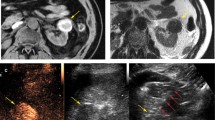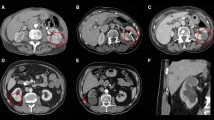Abstract
Objective
To evaluate the impact of anterior tumor location on oncologic efficacy, complication rates, and procedure duration for 151 consecutive biopsy-proven clinical T1a renal cell carcinoma (RCC) treated with percutaneous microwave (MW) ablation.
Methods
This single-center retrospective study was performed under a waiver of informed consent. One hundred forty-eight consecutive patients (103 M/45 F; median age 67 years, IQR 61–73) with 151 cT1a biopsy-proven RCC (median diameter 2.4 cm, IQR 1.9–3.0) were treated with percutaneous MW ablation between March 2011 and August 2017. Patient and procedural data collected included Charlson comorbidity index (CCI), RENAL nephrometry score (NS), use of hydrodisplacement, MW antennas/generator output/time, and procedure time (PT). Data were stratified by anterior, posterior, and midline tumor location and compared with the Kruskal–Wallis or chi-squared tests. The Kaplan–Meier method was used for survival analyses.
Results
Tumor size, NS, and use/volume of hydrodisplacement were similar for posterior and anterior tumors (p > 0.05). Patients with anterior tumors had a higher CCI (3 vs 4, p = 0.001). Median PT for posterior and anterior tumors was similar (100 vs 108 min, p = 0.26). Single session technical success and primary efficacy were achieved for all 151 tumors including 61 posterior and 67 anterior tumors. The 4 (3%) Clavien III–IV complications and 6 (4%) local recurrences were not associated with tumor location (p > 0.05). Three-year RFS, CSS, and OS were 95% (95% CI 0.87, 0.98), 100% (95% CI 1.0, 1.0), and 96% (95% CI 0.89, 0.98), respectively.
Conclusions
The safety and efficacy of percutaneous microwave ablation for anterior and posterior RCC are similar.
Key Points
• The safety profile for percutaneous microwave ablation of anterior and posterior T1a renal cell carcinoma is equivalent.
• Percutaneous microwave ablation of T1a renal cell carcinoma provides durable oncologic control regardless of tumor location.
• Placement of additional microwave antennas and use of hydrodisplacement are associated with longer procedure times.






Similar content being viewed by others
Abbreviations
- a:
-
Anterior
- BMI:
-
Body mass index
- CCI:
-
Charlson comorbidity index
- CECT:
-
Contrast-enhanced CT
- CS:
-
Conscious sedation
- CSS:
-
Cancer-specific survival
- CT:
-
Computed tomography
- ECOG:
-
European Cooperative Oncology Group
- GA:
-
General anesthesia
- IQR:
-
Interquartile range
- LTP:
-
Local tumor progression
- MRI:
-
Magnetic resonance imaging
- MW:
-
Microwave
- NS:
-
RENAL nephrometry score
- OS:
-
Overall survival
- p:
-
Posterior
- RCC:
-
Renal cell carcinoma
- RFS:
-
Recurrence-free survival
- US:
-
Ultrasound
- W:
-
Watts
- X:
-
Midline
References
Lightfoot N, Conlon M, Kreiger N et al (2000) Impact of noninvasive imaging on increased incidental detection of renal cell carcinoma. Eur Urol 37(5):521–527
Banegas MP, Harlan LC, Mann B, Yabroff KR (2016) Toward greater adoption of minimally invasive and nephron-sparing surgical techniques for renal cell cancer in the United States. Urol Oncol 34(10):433.e439–433.e417
Campbell S, Uzzo RG, Allaf ME et al (2017) Renal mass and localized renal cancer: AUA guideline. J Urol 198(3):520–529
Uhlig J, Strauss A, Rucker G et al (2019) Partial nephrectomy versus ablative techniques for small renal masses: a systematic review and network meta-analysis. Eur Radiol 29(3):1293–1307
Atwell TD, Farrell MA, Callstrom MR et al (2007) Percutaneous cryoablation of large renal masses: technical feasibility and short-term outcome. AJR Am J Roentgenol 188(5):1195–1200
Klapperich ME, Abel EJ, Ziemlewicz TJ et al (2017) Effect of tumor complexity and technique on efficacy and complications after percutaneous microwave ablation of stage T1a renal cell carcinoma: a single-center, retrospective study. Radiology 284(1):272–280
Wells SA, Wong VK, Wittmann TA et al (2017) Renal mass biopsy and thermal ablation: should biopsy be performed before or during the ablation procedure? Abdom Radiol (NY) 42(6):1773–1780
Atwell TD, Vlaminck JJ, Boorjian SA et al (2015) Percutaneous cryoablation of stage T1b renal cell carcinoma: technique considerations, safety, and local tumor control. J Vasc Interv Radiol 26(6):792–799
Kutikov A, Uzzo RG (2009) The R.E.N.A.L. nephrometry score: a comprehensive standardized system for quantitating renal tumor size, location and depth. J Urol 182(3):844–853
Atwell TD, Carter RE, Schmit GD et al (2012) Complications following 573 percutaneous renal radiofrequency and cryoablation procedures. J Vasc Interv Radiol 23(1):48–54
McClure TD, Chow DS, Tan N, Sayre JA, Pantuck AJ, Raman SS (2014) Intermediate outcomes and predictors of efficacy in the radiofrequency ablation of 100 pathologically proven renal cell carcinomas. J Vasc Interv Radiol 25(11):1682–1688 quiz 1689
Camacho JC, Kokabi N, Xing M et al (2015) R.E.N.A.L. (radius, exophytic/endophytic, nearness to collecting system or sinus, anterior/posterior, and location relative to polar lines) nephrometry score predicts early tumor recurrence and complications after percutaneous ablative therapies for renal cell carcinoma: a 5-year experience. J Vasc Interv Radiol 26(5):686–693
Haddad RL, Patel MI, Vladica P, Kassouf W, Bladou F, Anidjar M (2012) Percutaneous radiofrequency ablation of small renal tumors using CT-guidance: a review and its current role. Urol J 9(4):629–638
Lee SJ, Choyke LT, Locklin JK, Wood BJ (2006) Use of hydrodissection to prevent nerve and muscular damage during radiofrequency ablation of kidney tumors. J Vasc Interv Radiol 17(12):1967–1969
Charlson ME, Pompei P, Ales KL, MacKenzie CR (1987) A new method of classifying prognostic comorbidity in longitudinal studies: development and validation. J Chronic Dis 40(5):373–383
Dindo D, Demartines N, Clavien P-A (2004) Classification of surgical complications: a new proposal with evaluation in a cohort of 6336 patients and results of a survey. Ann Surg 240(2):205–213
Ahmed M, Solbiati L, Brace CL et al (2014) Image-guided tumor ablation: standardization of terminology and reporting criteria--a 10-year update. J Vasc Interv Radiol 25(11):1691–1705.e1694
Haddad MM, Schmit GD, Kurup AN et al (2018) Percutaneous cryoablation of solitary, sporadic renal cell carcinoma: outcome analysis based on clear-cell versus papillary subtypes. J Vasc Interv Radiol 29(8):1122–1126
Hao G, Hao Y, Cheng Z et al (2018) Local tumor progression after ultrasound-guided percutaneous microwave ablation of stage T1a renal cell carcinoma: risk factors analysis of 171 tumors. Int J Hyperthermia 2018:1–9
Breen DJ, King AJ, Patel N, Lockyer R, Hayes M (2018) Image-guided cryoablation for sporadic renal cell carcinoma: three- and 5-year outcomes in 220 patients with biopsy-proven renal cell carcinoma. Radiology. 289(2):554–561
Atwell TD, Schmit GD, Boorjian SA et al (2013) Percutaneous ablation of renal masses measuring 3.0 cm and smaller: comparative local control and complications after radiofrequency ablation and cryoablation. AJR Am J Roentgenol 200(2):461–466
Zhou W, Arellano RS (2018) Thermal ablation of T1c renal cell carcinoma: a comparative assessment of technical performance, procedural outcome, and safety of microwave ablation, radiofrequency ablation, and cryoablation. J Vasc Interv Radiol 29(7):943–951
Kim HJ, Park BK, Chung IS (2018) Comparison of general anesthesia and conscious sedation during computed tomography-guided radiofrequency ablation of T1a renal cell carcinoma. Can Assoc Radiol J 69(1):24–29
Funding
The authors state that this work has not received any funding.
Author information
Authors and Affiliations
Corresponding author
Ethics declarations
Guarantor
The scientific guarantor of this publication is Shane A. Wells.
Conflict of interest
The authors (JLH, FTL, TJZ, SAW) of this manuscript declare relationships with the following companies: Ethicon, Inc. (paid consultant).
Statistics and biometry
One of the authors (KAM) has significant statistical expertise.
Informed consent
Written informed consent was waived by the Institutional Review Board.
Ethical approval
Institutional Review Board approval was obtained.
Study subjects or cohorts overlap
Some study subjects or cohorts have been previously reported in Klapperich ME, Abel EJ, Ziemlewicz TJ, Best SL, Lubner MG, Nakada SY, Hinshaw JL, Brace CL, Lee FT Jr., Wells SA. Effect of tumor complexity and technique on efficacy and complications after percutaneous microwave ablation of stage T1a renal cell carcinoma: A single-center, retrospective study. Radiology 2017;284(1):272–280. PMID: 28076721.
Methodology
• retrospective
• cohort study
• single institution
Additional information
Publisher’s note
Springer Nature remains neutral with regard to jurisdictional claims in published maps and institutional affiliations.
Rights and permissions
About this article
Cite this article
Maciolek, K.A., Abel, E.J., Posielski, N.M. et al. Tumor location does not impact oncologic outcomes for percutaneous microwave ablation of clinical T1a renal cell carcinoma. Eur Radiol 29, 6319–6329 (2019). https://doi.org/10.1007/s00330-019-06121-y
Received:
Revised:
Accepted:
Published:
Issue Date:
DOI: https://doi.org/10.1007/s00330-019-06121-y




